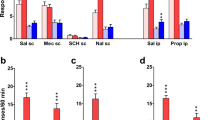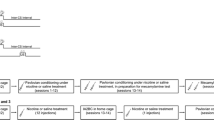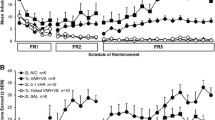Abstract
Rationale
Stimuli associated with nicotine can become motivationally significant and may play a role in tobacco dependence. Previous work indicates that nicotine enhances responding for a conditioned reinforcer (CR).
Objectives
These studies examined the effects of prior exposure to nicotine on responding for a CR, persistence of this response, and the role of α4β2 or α7 nicotinic receptor subtypes.
Methods
Water deprived rats were given 13 Pavlovian conditioning sessions where a light/tone conditioned stimulus (CS) was paired with the delivery of water. Then, rats were presented with two levers: one delivered the CS (now a CR), the other was inactive. Experiments examined the effect of nicotine administered prior to Pavlovian conditioning sessions on approach behavior during CS presentations, operant responding for CR in the presence and absence of nicotine, and the persistence of responding for CR. The effects of nicotinic acetylcholine receptor (nAChR) antagonism with mecamylamine and α4β2 or α7 nAChR antagonism with dihydro-beta-erythroidine (DHβE) or methyllycaconitine (MLA) on nicotine-enhanced responding for CR were examined.
Results
Nicotine enhanced approach behavior during CS presentations and potentiated operant responding for CR, an effect sensitized as a result of nicotine exposure during conditioning. Responding for CR and its potentiation by nicotine was stable over multiple tests. Enhanced responding for the CR induced by nicotine was blocked by mecamylamine and DHβE, but not MLA.
Conclusions
Nicotine enhances Pavlovian discriminated approach and shows sensitized nicotine-induced enhancements in responding for CR, an effect depending on α4β2 nAChRs.





Similar content being viewed by others
References
Beninger RJ, Phillips AG (1980) The effect of pimozide on the establishment of conditioned reinforcement. Psychopharmacology 68:147–153
Brunzell DH, Chang JR, Schneider B, Olausson P, Taylor JR, Picciotto MR (2006) β2-Subunit-containing nicotinic acetylcholine receptors are involved in nicotine-induced increases in conditioned reinforcement but not progressive ratio responding for food in C57BL/6 mice. Psychopharmacology 184:328–38
Burton CL, Nobrega JN, Fletcher PJ (2010) The effects of adolescent methylphenidate self-administration on responding for a conditioned reward, amphetamine-induced locomotor activity, and neuronal activation. Psychopharmacology 208:455–68
Burton CL, Noble K, Fletcher PJ (2011) Enhanced incentive motivation for sucrose-paired cues in adolescent rats: possible roles for dopamine and opioid systems. Neuropsychopharmacology 36:1631–1643
Caggiula AR, Donny EC, White AR, Chaudhri N, Booth S, Gharib MA, Hoffman A, Perkins KA, Sved AF (2001) Cue dependency of nicotine self-administration and smoking. Pharmacol Biochem Behav 70:515–530
Caggiula AR, Donny EC, White AR, Chaudhri N, Booth S, Gharib MA, Hoffman A, Perkins KA, Sved AF (2002) Environmental stimuli promote the acquisition of nicotine self-administration in rats. Psychopharmacology 163:230–237
Centers for Disease Control and Prevention (2012) Data and statistics. In: Smoking and tobacco use. Centers for Disease Control and Prevention. Available via DIALOG. http://www.cdc.gov/tobacco/data_statistics/index.htm. Accessed 23 March 2012
Chaudhri N, Caggiula AR, Donny EC, Booth S, Gharib M, Craven L, Palmatier MI, Liu X, Sved AF (2006) Operant responding for conditioned and unconditioned reinforcers in rats is differentially enhanced by the primary reinforcing and reinforcement-enhancing effects of nicotine. Psychopharmacology 189:27–36
Chiamulera C (2005) Cue reactivity in nicotine and tobacco dependence: a “multiple-action” model of nicotine as a primary reinforcement and as an enhancer of the effects of smoking-associated stimuli. Brain Res Rev 48:74–97
Clarke PBS, Kumar R (1983) Characterization of the locomotor stimulant action of nicotine in tolerant rats. Br J Pharmacol 80:587–94
Corrigall WA, Coen KM (1989) Nicotine maintains robust self-administration in rats on a limited-access schedule. Psychopharmacology 107:285–289
Corrigall WA, Koen KM, Adamson KL (1994). Self-administered nicotine activates the mesolimbic dopamine system through the ventral tegmental area. Brain Research 653: 278–284
Domino EF (2001) Nicotine induced behavioral locomotor sensitization. Prog Neuropsychopharmacol Biol Psychiatry 25:59–71
Donny EC, Chaudhri N, Caggiula AR, Evans-Martin FF, Booth S, Gharib MA, Clements LA, Sved AF (2003) Operant responding for a visual reinforcer in rats is enhanced by noncontingent nicotine: implications for nicotine self-administration and reinforcement. Psychopharmacology 169:68–76
Everitt BJ, Belin D, Economidou D, Pelloux Y, Dalley JW, Robbins TW (2008) Neural mechanisms underlying the vulnerability to develop compulsive drug-seeking habits and addiction. Philos Trans R Soc Lond B Biol Sci 363:3125–35
Ferrari R, Le Novere N, Picciotto MR, Changeux JP, Zoli M (2001) Acute and long-term changes in the mexolimbic dopamine pathway after systemic or local single nicotine injections. Eur J Neurosci 15:1810–8
Fowler CD, Arends MA, Kenny PJ (2008) Subtypes of nicotinic acetylcholine receptors in nicotine reward, dependence, and withdrawal: evidence from genetically modified mice. Behav Pharmacol 19:461–84
Franklin T, Wang Z, Suh JJ, Hazan R, Cruz J, Li Y, Goldman M, Detre JA, O’Brien CP, Childress AR (2011) Effects of varenicline on smoking cue-triggered neural and craving responses. Arch Gen Psychiatry 68:516–526
George TP, O'Malley SS (2004) Current pharmacological treatments for nicotine dependence. Trends Pharmacol Sci 25:42–48
Grottick AJ, Higgins GA (2000) Effect of subtype selective nicotinic compounds on attention as assessed by the five-choice serial reaction time task. Behav Brain Res 117:197–208
Grottick AJ, Trube G, Corrigall WA, Huwyler J, Malherbe P, Wyler R, Higgins GA (2000) Evidence that nicotinic alpha(7) receptors are not involved in the hyperlocomotor and rewarding effects of nicotine. J Pharmacol Exp Ther 294:1112–9
Imperato A, Mulus A, Di Chiara G (1986) Nicotine preferentially stimulates dopamine released in the limbic system of freely moving rats. Eur J Pharmacol 132: 337–338
Kenny PJ, Markou A (2006) Nicotine self-administration acutely activates brain reward systems and induces a long-lasting increase in reward sensitivity. Neuropsychopharmacology 31:1203–11
Laviolette SR, van der Kooy D (2003a) Blockade of mesolimbic dopamine transmission dramatically increases sensitivity to the rewarding effects of nicotine in the ventral tegmental area. Molecular Psychiatry 8:50–59
Laviolette SR, van der Kooy D (2003b) The motivational valence of nicotine in the rat ventral tegmental area is switched from rewarding to aversive following blockade of the α7-subunit-containing nicotinic acetylcholine receptor. Psychopharmacology 166:306–313
Laviolette SR, van der Kooy D (2004) The neurobiology of nicotine addiction: bridging the gap from molecules to behaviour. Nat Neurosci 5:55–65
Le Foll B, Goldberg SR (2005) Nicotine induces conditioned place preferences over a large range of doses in rats. Psychopharmacology 178:481–492
Liu X, Palmatier MI, Caggiula AR, Donny EC (2007) Reinforcement enhancing effect of nicotine and its attenuation by nicotinic antagonists in rats. Psychopharmacology 194:463–473
Lof E, Olausson P, Stomberg R, Taylor JR, Soderpalm B (2010) Nicotinic acetylcholine receptors are required for the conditioned reinforcing properties of sucrose-associated cues. Psychopharmacology 212:321–8
Mameli-Engvall M, Evrard A, Pons S, Maskos U, Svensson TH, Changeux JP, Faure P (2006) Hierarchical control of dopamine neuron-firing patterns by nicotinic receptors. Neuron 50:911–921
Markou A, Paterson NE (2001) The nicotinic antagonist methyllycaconitine has differential effects on nicotine self-administration and nicotine withdrawal in the rat. Nicotine Tob Res 3:361–73
Olausson P, Engel JA, Soderpalm B (1999) Behavioral sensitization to nicotine is associated with behavioral disinhibition; counteraction by citalopram. Psychopharmacology (Berl) 142:111–119
Olausson P, Jentsch JD, Taylor JR (2003) Repeated nicotine exposure enhances reward-related learning in the rat. Neuropsychopharmacology 28:1264–71
Olausson P, Jentsch JD, Taylor JR (2004a) Nicotine enhances responding with conditioned reinforcement. Psychopharmacology (Berl) 171:173–8
Olausson P, Jentsch JD, Taylor JR (2004b) Repeated nicotine exposure enhances responding with conditioned reinforcement. Psychopharmacology 173:98–104
Ortells MO, Barrantes GE (2010) Tobacco addiction: a biochemical model of nicotine dependence. Med Hypotheses 74:884–94
Padilla E, Barrett DW, Shumake JD, Gonzalez-Lima F (2009) Strain, sex, and open-field behavior: factors underlying the genetic susceptibility to helplessness. Behav Brain Res 201:257–64
Palmatier MI, Liu X, Caggiula AR, Donny EC, Sved AF (2007a) The role of nicotinic acetylcholine receptors in the primary reinforcing and reinforcement-enhancing effects of nicotine. Neuropsychopharmacology 32:1098–108
Palmatier MI, Liu X, Matteson GL, Donny EC, Caggiula AR, Sved AF (2007b) Conditioned reinforcement in rats established with self-administered nicotine and enhanced by noncontingent nicotine. Psychopharmacology 195:235–43
Palmatier MI, Matteson GL, Black JJ, Liu X, Caggiula AR, Craven L, Donny EC, Sved AF (2007c) The reinforcement enhancing effects of nicotine depend on the incentive value of non-drug reinforcers and increase with repeated drug injections. Drug Alcohol Depend 89:52–59
Parkinson JA, Olmstead MC, Burns LH, Robbins TW, Everitt BJ (1999). Dissociation in effects of lesions of the nucleus accumbens core and shell on appetitive pavlovian approach behavior and the potentiation of conditioned reinforcement and locomotor activity by d-amphetamine. J Neurosci 19: 2401–2411
Robinson TE, Berridge KC (1993) The neural basis of drug craving: an incentive-sensitization theory of addiction. Brain Res Rev 18:247–91
Roitman MF, Stuber GD, Phillips PEM, Wightman RM, Carelli RM (2004) Dopamine operates as a subsecond modulator of food seeking. J Neurosci 24:1265–71
Schilstrom B, Rawal N, Mameli-Engvall M, Nomikos GG, Svensson TH (2003) Dual effects of nicotine on dopamine neurons mediated by different nicotinic receptor subtypes. Int J Neuropsychopharmacology 6:1–11
Taylor JR, Robbins TW (1984) Enhanced behavioural control by conditioned reinforcers following microinjections of d-amphetamine into the nucleus accumbens. Psychopharmacology 84:405–12
Vezina P, McGehee DS, Green WN (2007) Exposure to nicotine and sensitization of nicotine-induced behaviors. Prog Neuropsychopharmacol Biol Psychiatry 31:1625–1638
Walters CL, Brown S, Changeux J, Martin B, Damaj MI (2006) The β2 but not the α7 subunit of the nicotinic acetylcholine receptor is required for nicotine-conditioned place preference in mice. Psychopharmacology 184:339–4
Acknowledgements
This research was funded by the Canadian Institutes of Health Research (CIHR). The authors thank Ashlie D. Soko for her technical help in various aspects of these experiments and J. D. Caleb Browne for his helpful comments on the manuscript.
Author information
Authors and Affiliations
Corresponding author
Rights and permissions
About this article
Cite this article
Guy, E.G., Fletcher, P.J. Nicotine-induced enhancement of responding for conditioned reinforcement in rats: Role of prior nicotine exposure and α4β2 nicotinic receptors. Psychopharmacology 225, 429–440 (2013). https://doi.org/10.1007/s00213-012-2832-8
Received:
Accepted:
Published:
Issue Date:
DOI: https://doi.org/10.1007/s00213-012-2832-8




